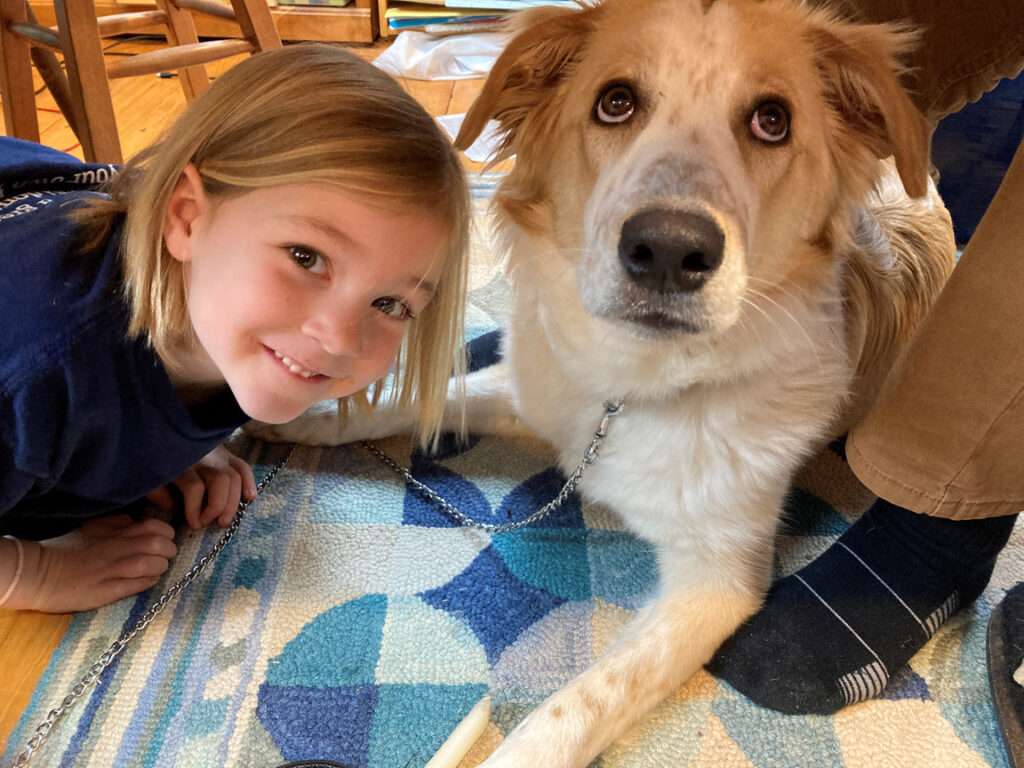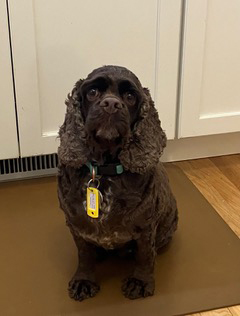
Penny, shown here with one of her humans, has trouble resisting the lure of the squirrels. (Photo provided)
The Dog Charmer by Tom Shelby
Off-leash Recall, Socialization in an
Entirely New Setting Discussed
Dear Tom,
Penny is 10 months old and we are again having difficulty with recall. We worked inside and treated successfully, then progressed to outside on a 20-foot lead rope—always treating, always praising—and made good progress until the squirrels showed up with the melting of the snow. I can’t compete with the entertaining lurements of rodents. Now we seem to be in a bad rut. Should I train a new recall word instead of “come”?
Thanks.
Mary
Dear Mary,
I think you’re off to a good start with Penny’s recalls.Two suggestions: I like to treat on the recall, most of the times, not every time. My experience has led me to feel that Penny may be more responsive if her attitude is “maybe there’s a treat, maybe not, I better go check it out.” Extra praise when there’s no treat. As for the lead rope you mention, it should be attached to a harness, not a collar, so as to avoid a serious injury if she takes off after a squirrel and the rope gets caught on something in mid-run.
One of the basic concepts of teaching the off-leash recall is slowly increasing the intensity of the distraction that the dog ignores and still comes when called. Most dogs are predatory. The nine-week-old puppy that chases the blowing leaf is a predatory response. The movement of the leaf elicits the prey drive.
Mary, the liklihood of Penny ignoring a running rabbit or squirrel because you changed the recall word is zero. She needs to be taught the “leave it” command. Every dog I work with is confronted with a plate of meat on the floor which she must ignore and walk around when I say “leave it.” That then expands to whatever I want her to keep her nose out of, be it a garbage can, a shoe, or a pizza crust on the sidewalk.
In the great majority of cases, the dog cooperates with the plate of meat on the floor with my voice intonation and a light leash correction. A leash correction is a well timed light snap of the leash coupled with my command, “Leave it!”
When timed properly, Penny will ignore (actually pretend to ignore) the plate of meat in less than two minutes. I will teach her “leave it” when we get together, and then discuss expanding her cooperation to the great outdoors when she’s off leash. One more thing; practice the recall indoors using dog treats and outdoors using people food treats like pieces of hot dog or chicken.
See ya soon.
Dog Charmer Tom
Dear Tom,

We recently brought a new dog into our family. She is now our adorable, Phoebe, a five-year-old American cocker spaniel. We drove to New Hampshire to get her from her home where she had been the female for a cockapoo breeder x2. She was part of their family home (six kids and lots of cockapoos.) Her owner decided she needed a new family to love her. She is a sweetheart, and is gentle, and loves our attention. We are also so fortunate that she is both crate- and “potty-” trained, and comfortable on leash—all the advantage of having an older dog. The issue now is her evident body language in fear of noises of all kinds! We have started CBD calming chews. We are seeing her vet this week and he will see her behavior firsthand. Our question to you is how we may best help our girl become more relaxed and secure as possible.
Kristi
Dear Kristi,
Congrats on your new family member and thank you for being one of the good guys by adopting an older dog. Having come from a family with six kids and other dogs, she is certainly somewhat socialized. However, my guess is she wasn’t really exposed to much else beyond the immediate family environment, and the total change of everything has her a little “freaked” out.
When it comes to socialization, I’m always referring to the same nine words—“Been there, done that, seen that, no big deal.” I’m not suggesting that you take her to a gun range or helicopter pad to get her used to loud noises, but rather with patience, love, and lots of special treats (meat), you slowly introduce her to the noises of the world beyond the the home.
A walk into town will start to aclimatize her to the hustle and bustle of noisy cars, motorcycles and people. What you don’t want to do is reward a fear response by telling her it’s okay and giving her treats when she’s clearly terrified. When she’s startled by the loud Harley taking off, your better response is an upbeat redirection, “Wow, Phoebe, that’s one noisy Harley. What do you think?” When she looks at you quizzacally, keep up with the happy talk and a couple of special treats. With some good acting and good timing, Phoebe will be looking for treats instead of trying to run away at startling noises.
If necessary, you can buy a CD with noises of thunder, sirens, explosions, etc. The key is to have success build on success. So play the CD softly enough so she can handle the sounds as she gets treats, while slowly increasing the volume; again, success building on success. She will probably come around to appreciating her new life with you quite soon.
Good luck.
Dog Charmer Tom
Tom Shelby’s book, “Dog Training Diaries,” was judged as one of the three best training books by Dog Writer’s Association of America.

